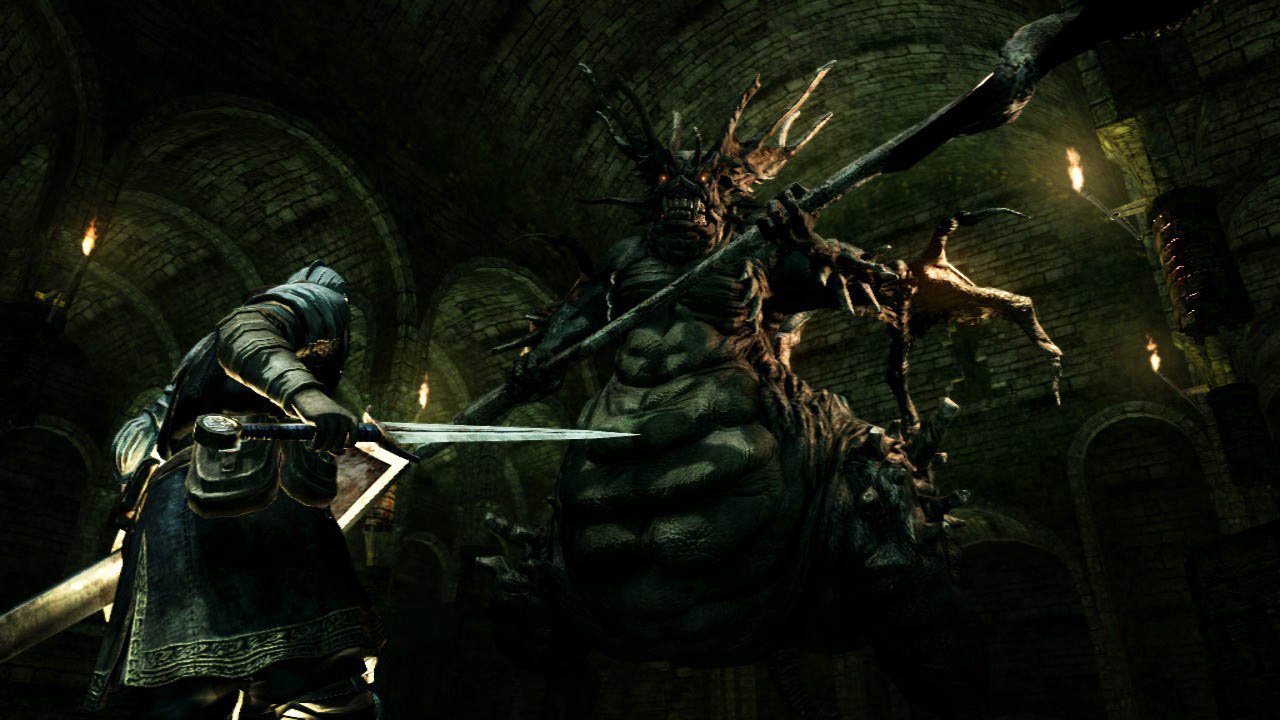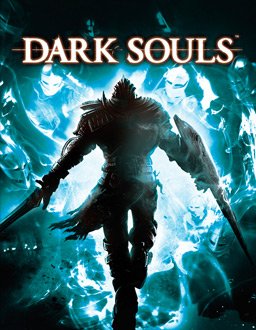From Software is back with the spiritual successor to one of the hardest games to hit the scene in years. Demons Soul’s made a splash both in Japan and in the West through sheer word of mouth and glowing reviews from the media. Two years later, Dark Souls is here, and it brings with it the same sense of accomplishment, excitement, brutality—and yes, genuine rage at times, with a gaming experience that is neither for the casual nor the faint-hearted. Many have claimed that this new game makes the original look like a McDonald’s children’s birthday party. But the truth is, the same old beast is beating under that bigger exterior, and it’s still just as addictive and rewarding as ever, even if the sheen of discovery has worn off some.
The First Death
Dark Souls’ advertising campaign is not a dare, or a challenge; it is merely some friendly advice. Sure, “Prepare to die,” sounds like a snappy slogan to create a false sense of provocation, but in this case they really are telling players in the bluntest, most direct way possible, what the game is truly about. This isn’t a direct sequel to Demon’s Souls in any way; it is not the same world and has no connection to the previous story. Now the player starts as prisoner in an asylum, condemned for the crime of being “Undead,” a curse which afflicts some with the ability to carry on after death as normal, although eventually it can lead to becoming a mindless, shambling zombie. From here, players—almost in a nod to Bethesda’s Elder Scrolls series—are freed, go through a typically brutal tutorial level, and then told that in order to have their true destiny revealed, they have to ring a couple of church bells. The game unfolds in its mischievous and often sadistic, rambling way from there.
When going over the presentation of Dark Souls, the first thing that is evident is that From Software’s artists are still the masters of varying shades and nuances of bleak. The greys, greens, and most importantly, blacks that they use throughout the various levels contribute to an overall feeling of emptiness and futility that is perfectly in keeping with the mood players will experience after a few hours of immersion. Environments are huge, marvellously-crafted, and show both a great use of textures and imagination in architecture. There’s also, unlike many games, a massive array of enemies that the player will encounter, with little in the way of cheap palette swaps to artificially bolster the rogue’s gallery. The art team is to be commended on the great job they’ve once again done in creating a look that can both impress and intimidate at the same time.
Unfortunately, this ambition seems to have come at the cost of performance. Dark Souls has some larger, much more expansive and complex areas than its predecessor. Regardless of which platform you play on, there will occasionally be dips in the framerate so significant—Blight Town is one of the earliest and worst examples of this—that it can actively interfere with your gameplay due to controller inputs being thrown off by the slowed down action. In a game where death has significant consequences for the player, this has far more impact than just a little aesthetic downgrade.
Sound however, is absolutely phenomenal, if familiar. Many audio effects, from the high-pitched buzz of acquiring souls to the firing of a soul arrow are taken straight from the Demon’s Souls audio library. The voice acting has the same off-kilter quality as Demon’s Souls, where there’s always a suspicion that nearly everyone encountered is slightly insane, perhaps homicidal. The music is spare, often absent during gameplay, only rising up as a haunting orchestra at certain rest areas, during cut-scenes and, most intensely, whenever boss encounters occur. However, it’s the sound effects at their best that create a heightened sense of immersion. This is particularly true for those with surround sound set ups, since the directional audio can literally save lives if you stop, listen and hear footsteps sneaking up behind you. Few games use audio as effectively as Dark Souls, not just as an aural accompaniment, but a component of gameplay that can be critical to survival in a game that relishes in back-stabbing ambushes. Like everything else about the game, From Software always gives players an out, but only if they’re fast, and paying attention.
The Many Deaths Thereafter
Death, unlike other games, has consequences that can occasionally leave a player devastated and potentially filled with rage. Of course, this is nothing new for veteran Demon’s Souls players. It’s hard to decide whether Dark Souls is actually a sequel, or merely an expansion or re-interpretation of Demon’s Souls. Much of the game is mechanically identical to its predecessor, and of course the philosophy and audience of the game remains the same; provide a hardcore gaming experience rarely available these days. The game shows the same influence of From Software’s earlier King’s Field series, and has much more in common with the CRPG genre of the 80s and 90s than it does with the JRPG genre that is From Software’s native culture. This is not a game about lanky amnesiac orphans and their adolescent crushes as they fight ancient evils; this is more about an in-depth, action-RPG that presents a wealth of character development options and a brutal, unforgiving environment to negotiate.
As with the original, players will choose a starter class which determines a few basic characteristics, and from there,they are free to explore and develop as they see fit. And die. A lot. This game, despite its 21st century presentation, is very much a throwback, hearkening to an age of gaming that was more about discovery and education than it was the fulfillment of power fantasies. The third-person combat is real-time and action oriented, but that is drapery against an overall structure of a numbers-driven role-playing game. Even the ability to fight is limited by a stamina bar which in turn is defined by how many points you are willing to pour into as you accrue experience points and level up. While the game gives you vague clues as to what your objectives might be, it never tells you specifically where you have to go and how you need to get there. Even the basics, such exact nuances of online interaction are as much a mystery to be plumbed as the next dungeon in bleak, often intimidating adventure.
So far all of this sounds like typical Demon’s Souls, but there have been some changes in the interim. The new world is, as expected, bigger. Developer claims are that it’s three to four times larger than the original, and that seems about right. The biggest change environmentally is that it’s now one large, open, seamless world. The only loading you see is when you die, and when you later get an ability to teleport between “bonfires,” the checkpoints of the game. The “world tendency” of Demon’s Souls has been removed so there’s no longer an apparent increase or decrease in difficulty based on your actions or the whims of the publisher. Another major change is the way death works. In the original, death meant you lost all your souls—the in-game currency for both items and experience points—and that you came back as a “ghost” version of yourself with only half of your total health available unless you killed a boss, or used an item to return yourself to life. In Dark Souls, death returns you to a “Hollowed” state, where you are considered undead, but still have full health, and in some cases, better resistances to certain attacks. The downside to being hollow is that you have a reduced chance of getting rare loot and, like the original, cannot summon other players into your world to assist. Like Demon’s Souls, a return to life offers certain benefits, but also leaves you open to world invasion.
The other change is that sorcery and divine (healing) magic are no longer abilities with their own gauge to determine how many spells can be cast. Instead, spells are now determined by the type of spell, and how many “slots” you have available. So a low level offensive spell can be cast 30 times if you equip it one slot, but if you acquire the spell twice, and equip to two slots, you can cast it 60 times. Or equip one low level offensive spell to one slot, and equip a healing spell to the other. This design decision is an obvious response to some of the more drastic exploits players used to glitch their way to easier victories in Demon’s Souls. It still makes magic users offensive power houses, but severely limits just how often they can cut loose.
And of course, there is the online component. In a move sure to infuriate Xbox Live owners, From Software—with the surprising consent of Microsoft—has disabled any ability to chat with players. Even attempting to use the party chat system will be detected and result in a boot back to the main menu. PS3 veterans of Demon’s Souls will be familiar with this, but things have gotten broader in scope with the addition of covenants. Covenants are in-game factions that players may opt to join, and these factions actually lend some order to the previous total chaos of world invasion. Players can actually “indict” invaders and put them a book that others may consult to see who needs hunting down. NPCs can also do this if they feel slighted by player actions. Now there’s more to invading than simply doing it for the thrill of PvP and perhaps some extra loot like Humanity, there are organized ramifications which can potentially put griefers on a Most Wanted list.
All this taken into consideration, the big question many of the uninitiated will have is “Is it really that hard?” and the answer is assuredly “Yes.” If you’re not an old school gamer, the mercilessness of this game may be simply too much for you to take. For veterans of Demon’s Souls, the question will be, “Is it really that much harder than the original?” and the answer to that is, “It’s harder, but not dramatically so.” The levels themselves are more difficult than Demon’s Souls, with more fiendish traps and designs in addition to their larger size. However, the more hostile environment is balanced off by new concessions such as the bonfire/checkpoint system, the reduction of penalty upon death, the inclusion of free healing items in the form of Estus flasks, and even the revamped systems for poison and curses that give players a fighting chance and eliminate some of the tedium that occasionally slowed Demon’s Souls. Online play—whether to assist or to invade—has unfortunately been hampered by the anticipation of more players with more servers, significantly dividing players, making it much harder to connect with others, particularly with the new rules for how matched-by-level players must be for an assist or invasion to take place.
On the whole, what we have with Dark Souls is a game that feels much like the original, with a few new design tweaks that add more depth to a game that already had an impressive scope. The experience is let down by some significant technical issues, such as the frame rate drops, and the uneven implementation of servers for online play can noticeably interfere with the game. That aside however, the core of the game remains compelling, brilliantly designed and obviously not for everyone. While Dark Souls is a game every hardcore gamer should try, it is also a game that mainstream or casual gamers should stay far away from. This is not a game for players only looking for quick bout of fun. Like a new trade or skill, this is a game that actually requires investment, time, study, discipline and diligence in order to reap rewards. If you are that kind of gamer, then get this immediately.






